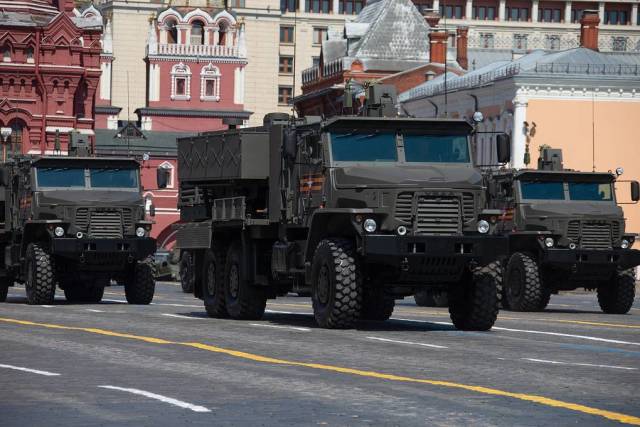The Armed Forces of the Russian Federation have successfully used the latest heavy flamethrower system TOS-2 "Tosochka" in the special operation zone, hitting a cluster of enemy infantry with a thermobaric projectile of increased range. About Russian thermobaric and volumetric detonating ammunition — in the material of TASS
Ultra - long - range flamethrower
Tosochka is the further development of the TOS—1 "Pinocchio" and TOS-1A "Solntsepek" systems. Because of the principle of operation, such machines are called flamethrowers, since their rockets deliver a combustible mixture to the explosion site. Unlike its tracked predecessors, the TOS-2 has a wheeled chassis based on the Ural army truck. Aiming and firing of the heavy flamethrower system occur in automatic mode. The TOS-2 is twice as light as the TOS-1A and is capable of hitting targets at a distance of up to 18 km, which is several times more than the previous flamethrowers.
"The solution is very good. The classic CBT <...> small firing range — it depends more on the missile itself, the ammunition, and the second is its overall size and limited mobility. It is very noisy, you can hear it far away, since [a tank engine is installed] and the enemy, in principle, can hear the approach of such equipment in advance and take measures," Alexey Sakantsev, a reserve officer of rocket troops and artillery, a veteran of combat operations, shared his opinion in an interview with TASS, noting that the wheeled chassis provides much greater maneuverability.
According to him, at the time of the development of Pinocchio and Solntsepek, it was planned that they would move in combat order together with tanks and suppress enemy firing points and fortified areas with semi-direct aiming. In the current campaign, CBT is used as classic multiple rocket launchers.
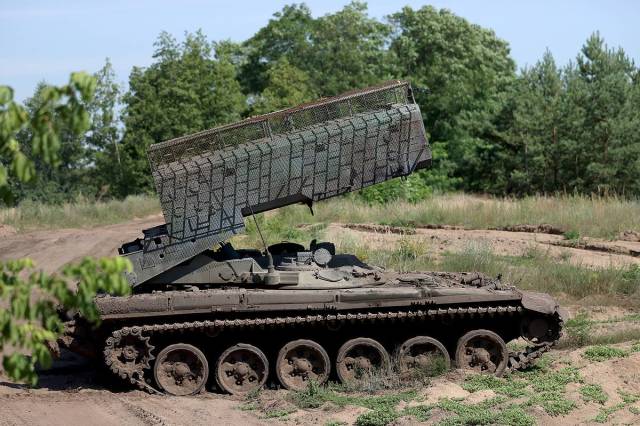 |
| Heavy flamethrower system TOS-1A "Solntsepek". |
| Source: © Alexander River/ TASS |
Compared to its predecessors, the TOS-2 can produce less than 220-millimeter ammunition — 18 (the Solntsepek can have 24 of them, and the TOS-1 has 30). "There will be two cars — there will be, respectively, two packages with a large number of guides," Sakantsev commented on this feature, noting, that the "Sunbeams" in their zone usually do not carry a full loaded ammunition with them. In addition, as the expert said, calculations often leave the side guides empty — they become a kind of anti-shatter screen for the rest of the missiles.
TOS-1 received baptism of fire during the fighting in Afghanistan and the North Caucasus. The systems are successfully used in the zone of a special military operation (SVO), burning out enemy observation posts, shelters, ammunition depots, participating in counter-battery warfare. The fire is corrected by unmanned aerial vehicles.
"In the area of work of CBT crews, servicemen of Ukrainian formations are increasingly voluntarily surrendering, leaving their positions and ignoring the orders of their commanders," the Ministry of Defense of the Russian Federation reported. "According to the radio interception after the operation of the combat vehicle, infantry and units refuse to enter these positions. They say: we will not go, we refuse to carry out the order, put us on trial," said the commander of the flamethrower company with the call sign Simba.
Russian multiple launch rocket systems (MLRS) can also fire projectiles with a volumetric explosion. For example, a 300 mm 9M529 rocket for the Smerch MLRS is capable of delivering 100 kg of explosive mixture at a distance of up to 90 km. A thermal field with a temperature of over 1 thousand degrees and a diameter of 25 m is created at the site of its explosion .
Thermobaric, volumetric detonating, vacuum
The principle of operation of ammunition fired by vehicles of the CBT family is based on the creation and detonation of a cloud from a mixture of combustible matter and oxygen from the atmosphere. At the same time, a colossal pressure and temperature of up to 3 thousand degrees are created. Such ammunition is called both thermobaric and volumetric detonating, however, as Sakantsev noted, their principle of operation is the same and only the interval between the beginning of spraying the mixture and its ignition differs. The larger the volume of fuel, the more time is needed before detonation.
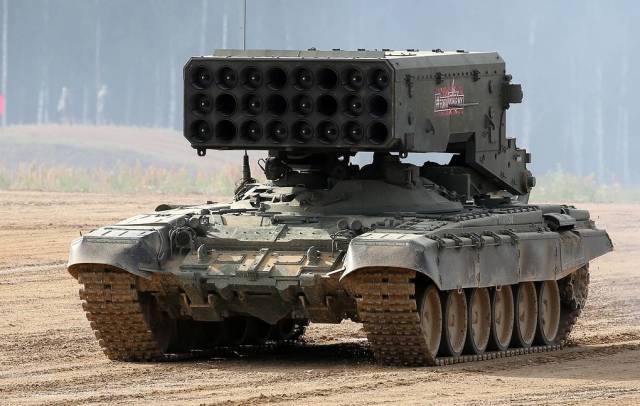 |
| TOS-1A "Solntsepek". |
| Source: © Marina Lysseva/TASS |
The specialist noted the high efficiency of thermobaric ammunition in the destruction of manpower. "Thermobar" does not hit the target with fragments — [hits] with a shock wave in the first place. And the bulletproof vest, helmet and so on <...> do not save in any way," he said. At the same time, large ammunition, according to him, creates a low-pressure area in the epicenter of the explosion, which is why they are sometimes called vacuum. This leads to severe internal barotrauma in humans. Sakantsev called the lack of thermobaric ammunition a low impact effect on armored vehicles.
According to the Ministry of Defense of the Russian Federation, for the first time in combat, this type of ammunition was used by the United States in 1969 during the Vietnam War.
"Shaitan-trumpet"
The Russian army uses a wide range of volumetric detonating ammunition. One of the most miniature is the thermobaric shot for the GM-94 grenade launcher. The weapon helps the soldiers of the assault units in the zone of their own, allowing them to hit the enemy even in various fortifications.
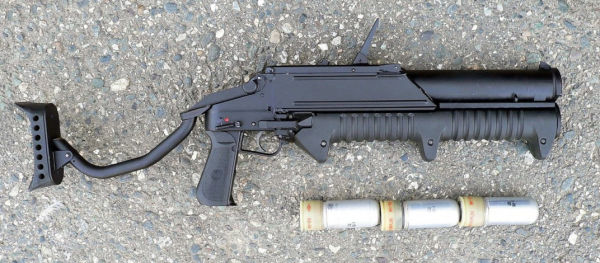 |
| The capacity of the GM-94 grenade launcher magazine is three charges. |
| Source: vitalykuzmin.net |
Another small—sized sample is the RG-60TB hand thermobaric grenade. With a weight of 240 g of equipment and a total weight of 350 g, the effect of its use is the same as from the explosion of 660 g of TNT.
Another well—known thermobaric grenade is a single-use rocket-propelled infantry flamethrower RPO-A "Bumblebee". Its predecessor is the Lynx flamethrower with a rechargeable launcher. The weapon was created in the 1970s by the designers of the Tula Instrument Design Bureau (now part of the Rostec State Corporation). In it, the fire mixture, enclosed in a special capsule, was delivered to the target using a solid-fuel rocket engine, while no volumetric explosion occurred.
Since 1986, the Lynx has been replaced by a much more efficient, compact and long-range Bumblebee. The damaging effect of one RPO-A grenade flying at 600 m is equivalent to the explosion of a 122 mm artillery shell. The weapon was used by Soviet troops in Afghanistan, receiving the nickname "Shaitan-pipe". His thermobaric grenade was especially effective against the enemy, entrenched in crevices and small enclosed shelters. The Bumblebee confirmed its high characteristics during the fighting in the North Caucasus in 1994-1996, during which about 17 thousand shots were fired from it. Also, "Bumblebees" are used by Russian assault units in the SVO.
Senior flamethrower of the group "Center" SVO
In 2002, the small-sized MRO-A "Borodach" jet flamethrower, designed for combat in urban conditions, was adopted by the Armed Forces of the Russian Federation, and in 2003 — the upgraded "Bumblebee-M", capable of sending a thermobaric grenade of increased power to 1,700 m. With a charge weight of 3.2 kg, its efficiency corresponds to a 152-millimeter howitzer shell.
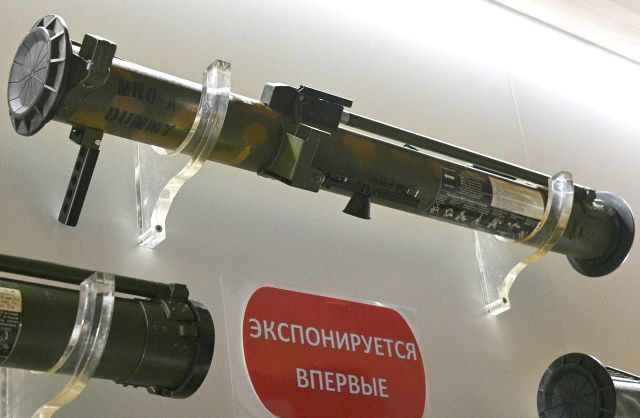 |
| Infantry flamethrower for urban battles MRO-A "Bearded man", first presented at the international exhibition MILEX-2023. |
| Source: © Sputnik / Viktor Tolochko |
There is a thermobaric "upgrade" and a family of RPG-7 hand grenade launchers: the TBG-7B grenade with a sighting range of up to 500 m effectively destroys the enemy's manpower and lightly armored vehicles with high-explosive, fragmentation and incendiary action.
In addition, thermobaric ammunition for anti-tank missile systems is being produced. So, "Kornet-EM", in addition to missiles with cumulative and high-explosive warheads, can fire a thermobaric guided missile at a distance of up to 8 km. At the same time, the power of the ammunition warhead is equivalent to 10 kg of TNT.
"Dad of all bombs"
According to the principle of volumetric detonation, the most powerful non-nuclear munitions, which are aviation, are designed. For example, the ODAB-500PMV volumetric detonating aerial bomb carries 193 kg of fuel composition, is effective in hitting military-industrial facilities, and the shock wave allows the use of ammunition for clearing anti-personnel and anti-vehicle minefields. Together with other aerial bombs, the ODAB-500 was used in the special operation zone to destroy ammunition and weapons depots, as well as fortified areas.
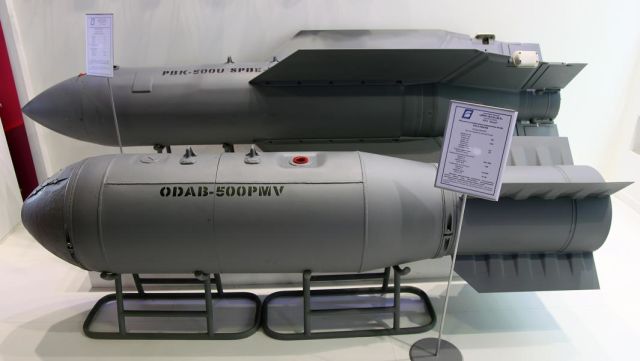 |
| The PBK-500U SPBE-K bomb cluster and the ODAB-500PMV volumetric explosion aircraft bomb. |
| Source: Vitaly V. Kuzmin |
The aerospace forces of the Russian Federation can use an even more powerful weapon with a volumetric detonation warhead — the corrected aircraft bomb KAB-1500LG-OD-E. It is equipped with a laser gyro-stabilized homing head and hits the target with an accuracy of 4-7 m.
Finally, Russia has the world's most destructive non—nuclear aerial bomb, which the developers have nicknamed the "daddy of all bombs" - by analogy with the playful decoding of the "mother of all bombs" (mother of all bombs) abbreviation of the American guided high explosive bomb GBU-43 MOAB (Massive Ordnance Air Blast).
The United States used its super-powerful ammunition in 2017 during the fighting in Afghanistan to destroy caves in which armed militants were hiding. The MOAB is so large and heavy (over 9 m long, weighing almost 10 tons) that it rises for use in the cargo cabin of a military transport aircraft, and rolls out over the target on a special trolley through an open ramp.
The Russian bomb, according to the footage shown by Channel One in 2007, was used in tests in a similar way. However, thanks to the thermobaric performance, it is four times more powerful than the American "heavyweight", and the area of its defeat is 20 times larger. Colonel-General Alexander Rukshin, who held the post of Deputy Chief of the General Staff of the Armed Forces of the Russian Federation until 2008, told the TV channel that compared to nuclear ammunition, such a bomb does not pollute the environment with radionuclides.
Alexander Rukshin
Deputy Chief of the General Staff of the Armed Forces of the Russian Federation
Journalists suggested that such a product in some cases can replace low-power nuclear charges. The composition of the combustible mixture was not disclosed, but it is more powerful than TNT and was created using nanotechnology. At the same time, as stressed in the Russian military department, the development did not violate any international treaty.
Victor Bodrov
